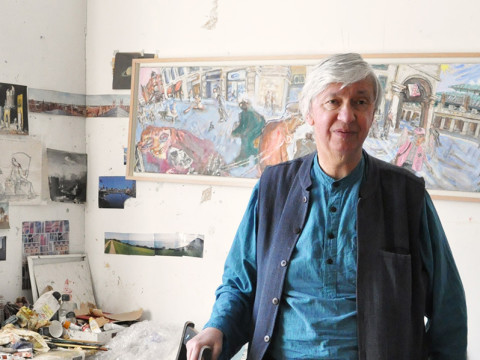
Remembering Sir Philip Dowson PRA
By Sir Michael Hopkins RA
Published on 27 August 2014
A few personal notes on a fellow architect and mentor by Sir Michael Hopkins RA.
At the Royal Academy, Philip should and will always be remembered as the President who saw the opportunity presented to the Academy when the Museum of Mankind moved back to Bloomsbury, leaving their Burlington Gardens building vacant. It was directly behind the Academy, even sharing the same axis. Naturally his first thoughts were to come up with some preliminary ideas about how you might join the two buildings together, to nearly double the space available to the Academy. Using this knowledge with his reputation as an architect and his ability to be taken seriously by Government, he prised the freehold out of them for a modest £5 million. A bargain then and the equivalent price today of a very small shoe box in Mayfair.

I didn’t know Philip as a young architect. I came to know him in the early 70’s, when he was fully formed, at the top of his game as founding partner in 1963 and driving force at Arup Associates - soon much in demand at Oxford and Cambridge, as well as by a whole string of blue chip corporate clients requiring new headquarters or prestigious production plants. Working for IBM in Portsmouth on three buildings at the same time, he had one too many. I was working with Norman Foster at the time and Philip suggested that we should take on the design of their temporary offices, 250,000 square feet – a fantastic opportunity. They are still in use, 40 years later.
Philip was always very generous with his time and energy in the support of younger architects, taking on the mantle of Hugh Casson, Robert Matthew and Leslie Martin – the architectural knights – as the patron of younger architectural practices. Something we seem less good at today.
Early on in my own practice, we won a competition to design a replacement building for the Financial Times next to St. Paul’s. Our proposed scheme transformed the existing building and was immediately sold on, for a huge sum, to a Japanese developer, and promptly Listed. Philip rang me up to say “Michael, do you know your client is going around town looking for an Architect who knows the Queen and they have approached me?" My response was “Crikey - it’s my most important project, couldn’t you be a consultant”. He agreed, and took all the client flack off my shoulders, helping me with the design of the building, leaving me to get the credit and the fee which he negotiated on my behalf on several visits to Japan bearing gifts (Lucy Rie pottery, which he chose). I think he delighted in the process – I know I did.

Norfolk and Suffolk are shared territories and influence on both Philip and me. Philip by birth, me by adoption. He, on the Waveney and me on the Alde – close to one of his most seminal projects – the conversion of part of the Maltings at Snape, into Benjamin Britten’s Concert Hall. Here he worked with his engineering partner and acoustician, Derek Sugden. Designed and built from 1965 – 67, they showed us how to do a major modern intervention – a Concert Hall , seating 800 people – in a redundant agri-industrial building, making it seem effortless, as though it had always been there, rising out of the reed beds. Now it is one of the most treasured places in England.
Late on, although hard of hearing and with speech that was sometimes difficult for others to understand, it was still possible to hold a cogent and humorous conversation about some aspect of architecture and society right up to his last visit to the Academy. He possessed delight and integrity to the end. An admirable man and colleague. I will miss him and so will many of my fellow Academicians.
Related articles

In memoriam: Norman Ackroyd RA
20 September 2024

In memoriam: Timothy Hyman RA
12 September 2024
